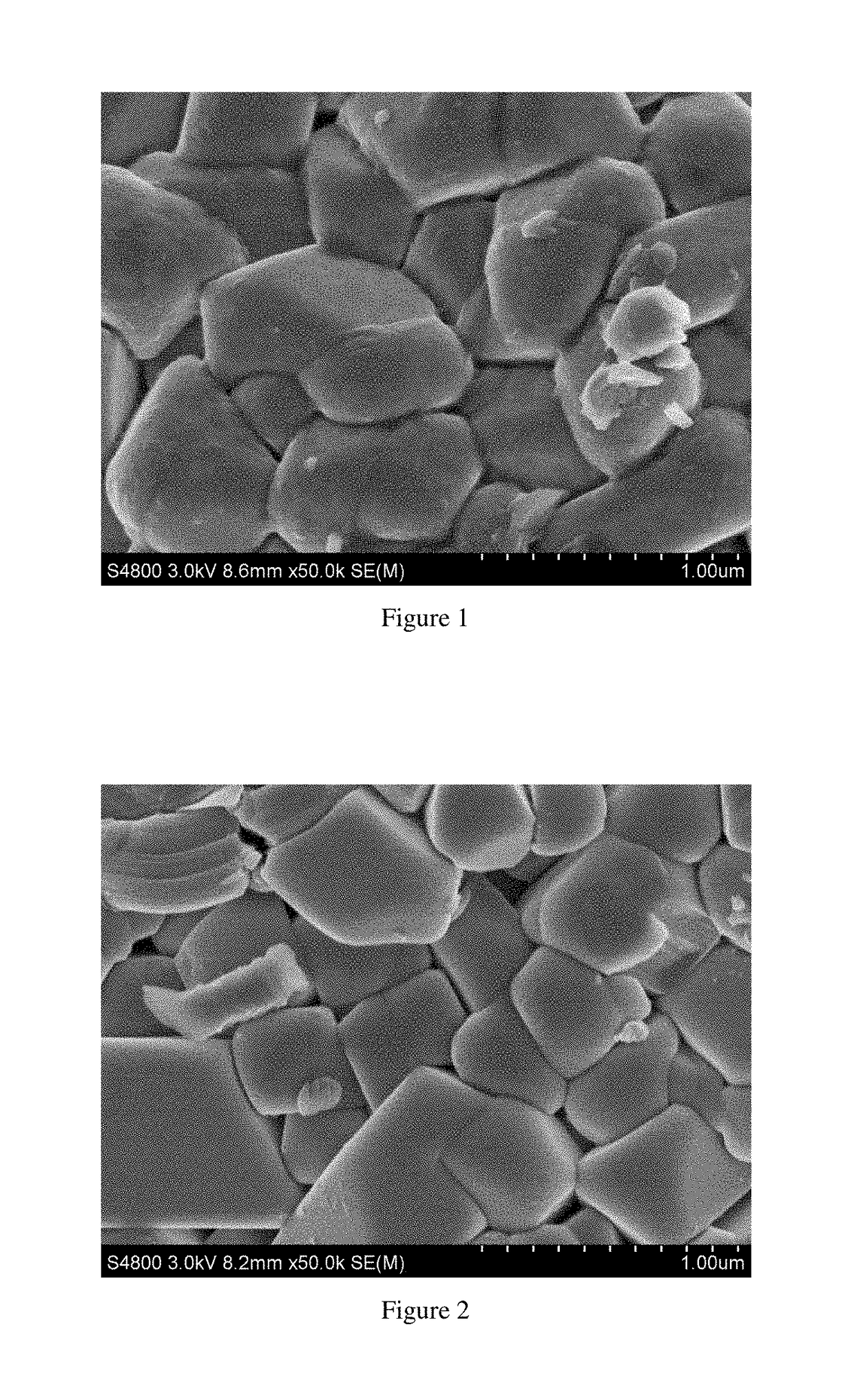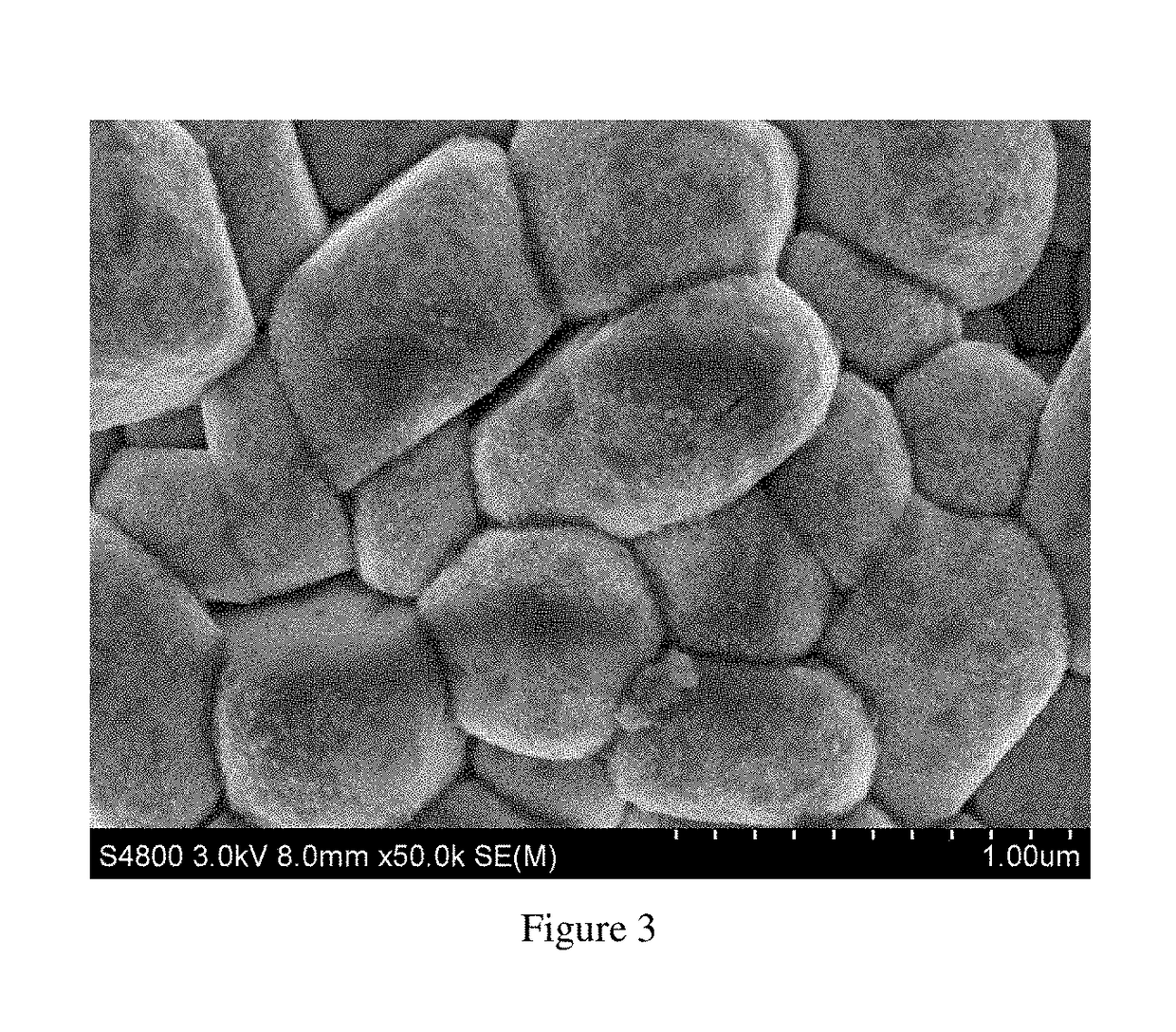Cathode material of lithium-nickel-cobalt-aluminum composite oxide, a method of fabricating the same and a lithium ion battery including the same
a lithium ion battery and composite oxide technology, applied in the field of lithium ion batteries, can solve the problems of poor processability, material itself still has some drawbacks to be solved, and it is difficult to meet the requirements of high output power and long service life, and achieve excellent storage and cycling performance, and low impurity of lithium
- Summary
- Abstract
- Description
- Claims
- Application Information
AI Technical Summary
Benefits of technology
Problems solved by technology
Method used
Image
Examples
embodiment 1
[0063]The lithium carbonate and Ni0.99Co0.01Al0.01(OH)2 are added in a ratio of Li / M=1.05:1 into a three-dimensional mixer and mixed at a frequency of 30 Hz for 3 hours to obtain a homogeneous mixture; The mixture is placed in the atmosphere sintering furnace, heated to 750° C. with a heating rate of 3° C. / min and kept for 10 hours. Oxygen is continuously infused at a rate of 20 mL / min during the calcination process. After calcination, it is naturally cooled down to room temperature, then subjected to pulverization, classification and screening to obtain the base material LiNi0.99Co0.01Al0.01O2. 1,000 g base material is slowly added into 1,000 g mixed solution (700 g methanol and 300 g acetic acid) and stirred continuously at a speed of 100 rpm for 120 minutes to obtain suspension. The suspension is placed in centrifugal machine and centrifuged at a speed of 6,000 rpm for 10 minutes. Then it is washed with methanol for 3 times. The materials after washing is transferred to a vacuum ...
embodiment 2
[0064]The lithium hydroxide and Ni0.90C0.05Al0.05(OH)2 are added in a ratio of Li / M=1.08:1 into a three-dimensional mixer and mixed at a frequency of 20 Hz for 8 hours to obtain a homogeneous mixture. The mixture is placed in the atmosphere sintering furnace. With a heating rate of 2° C. / minute, the temperature is raised to 800° C. and kept for 6 hours. Oxygen is continuously infused at a rate of 60 mL / minute during the calcination process. After calcination, it is naturally cooled down to room temperature, then subjected to pulverization, classification and screening to obtain the base material LiNi0.90Co0.05Al0.05O2. 1,000 g base material is slowly added into 500 g mixed solution (350 g ethanol and 150 g formic acid) and stirred continuously at a speed of 200 rpm for 30 minutes to obtain suspension. The suspension is placed in centrifugal machine and centrifuged at a speed of 7,000 rpm for 5 minutes. Then it is washed with ethanol for 5 times. The materials after washing is transf...
embodiment 3
[0065]The lithium carbonate and Ni0.08Co0.15Al0.05(OH)2 are added in a ratio of Li / M=1.02:1 into a three-dimensional mixer and mixed at a frequency of 30 Hz for 10 hours to obtain a homogeneous mixture. The mixture is placed in the atmosphere sintering furnace. With a heating rate of 8° C. / minute, the temperature is raised to 780° C. and kept for 20 hours. Oxygen is continuously infused at a rate of 5 mL / minute during the calcination process. After calcination, it is naturally cooled down to room temperature, then subjected to pulverization, classification and screening to obtain the base material LiNi0.80Co0.15Al0.05O2. 250 g base material is slowly added into 1,000 g mixed solution (800 g ethanol and 200 g propionic acid) and stirred continuously at a speed of 300 rpm for 180 minutes to obtain suspension. The suspension is placed in centrifugal machine and centrifuged at a speed of 8,000 rpm for 20 minutes. Then it is washed with ethanol for 4 times. The materials after washing is...
PUM
| Property | Measurement | Unit |
|---|---|---|
| frequency | aaaaa | aaaaa |
| temperature | aaaaa | aaaaa |
| temperature | aaaaa | aaaaa |
Abstract
Description
Claims
Application Information
 Login to View More
Login to View More - R&D
- Intellectual Property
- Life Sciences
- Materials
- Tech Scout
- Unparalleled Data Quality
- Higher Quality Content
- 60% Fewer Hallucinations
Browse by: Latest US Patents, China's latest patents, Technical Efficacy Thesaurus, Application Domain, Technology Topic, Popular Technical Reports.
© 2025 PatSnap. All rights reserved.Legal|Privacy policy|Modern Slavery Act Transparency Statement|Sitemap|About US| Contact US: help@patsnap.com


